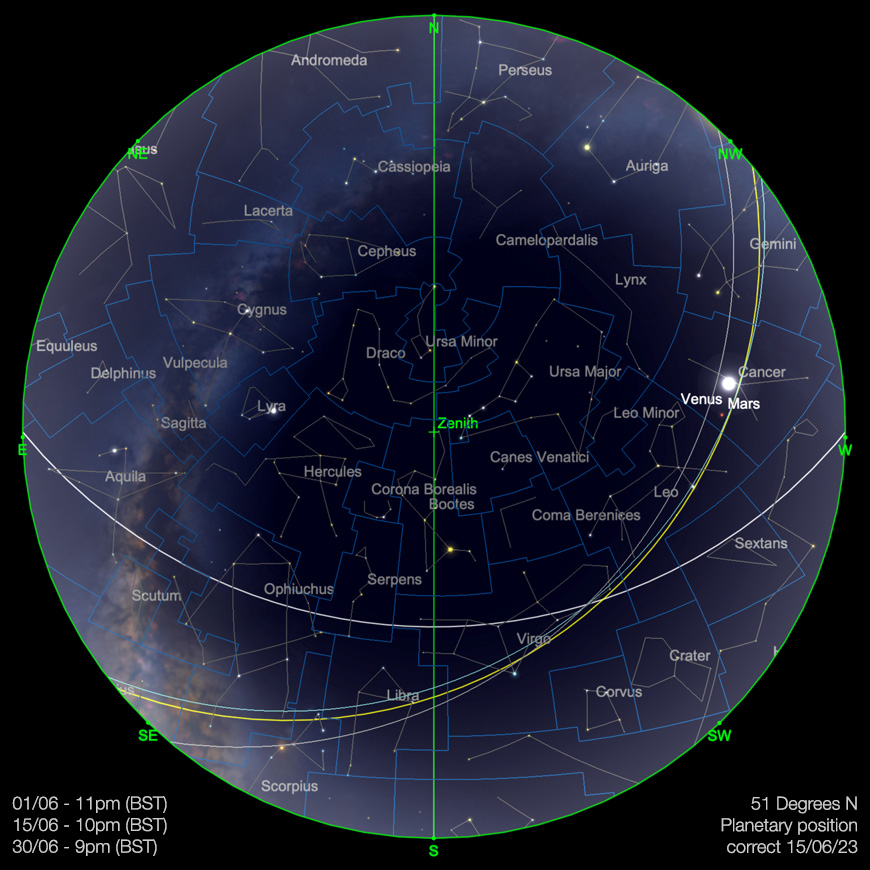June holds great significance for astronomers in many ways. For those of us residing in the Northern Hemisphere, June represents the brightest part of the year. This is as a result of the Summer Solstice, which occurs on June 21st in the Northern Hemisphere. During this event, the Sun reaches its most northerly point in the Ecliptic, resulting in the highest separation from the horizon at Midday. While we Northerners enjoy the glory of Midsummer, our counterparts in the Southern Hemisphere endure the grip of Midwinter. These extremes, as well as all our seasonal weather on Earth, are caused by our planet's rotational tilt, which is approximately 23.5 degrees from the vertical in comparison to the plane of our orbital path around the Sun.
During the summer season, the hemisphere facing the Sun receives more light, thereby warming up the land and sea. Consequently, the days become longer and the nights shorter as you move closer to the pole. Those residing above the Arctic Circle experience 24-hour daylight during Midsummer. Conversely, the opposite holds true for those in the “trailing” Southern hemisphere.
These circumstances noticeably affect the quality of darkness for individuals in temperate Northern latitudes. Even during the deepest part of the night, the Sun is not significantly below the horizon. This phenomenon creates a state of permanent Astronomical Twilight for a while around the Summer Solstice, particularly for those in Northern Europe, the Northern parts of the USA and Canada, and Asia. From the 27th of May to 15th July 2023, individuals in southern UK latitudes (around 50.5 degrees N) experience permanent Astronomical Twilight, meaning that the Sun remains less than 18 degrees below the horizon throughout the night. Consequently, the skies never truly darken, and objects with a magnitude of around 6 or lower cannot be discerned with the naked eye. It is worth noting that the limit of human eyesight typically falls around +6.5 magnitude, although this can vary from person to person. This has understandable implications for the quality of deep sky observation and astrophotography possible during this time of the year.
The further north one ventures, the longer the period of permanent Astronomical Twilight persists. In Manchester, UK (latitude 53.5 degrees N), this period extends from mid-May to the end of July. In Edinburgh (just shy of 56 degrees N), the duration is even longer, lasting from early May to the end of the first week of August. However, in locations similar to Reykjavik, Iceland (64 degrees N), Astronomical Twilight persists from early April to the beginning of September. North of the Arctic Circle, the Sun does not set at all around the Solstice, while south of the Antarctic Circle, the Sun does not rise during this period.
Supernova SN 2023ixf In M101 (Ursa Major)
When a massive star reaches the end of its life, it undergoes a powerful explosion, creating a dazzling burst of light that can temporarily alter the appearance of the night sky. The most brilliant and nearby supernovae can be observed without any special equipment, while even those occurring in distant galaxies can be easily detected using amateur telescopes from the comfort of your own backyard. A particularly exciting opportunity has now presented itself: A supernova has recently occurred in the neighbouring spiral galaxy M101 (NGC 5457) and you can locate it in the sky tonight. While this Supernova emphatically won't be casting shadows anywhere on Earth, it is located in a well-known and easy to find object and well in the rear of many amateur telescopes.
As shown in the chart above, M101's location is very easy to find: the galaxy sits at the peak of a triangle formed by the two stars at the end of the handle of The Plough, or Big Dipper - Mizar and Alkaid. You can actually follow a small trail of fainter stars: 81 UMa, 82 Uma, 83 Uma and 86 Uma up from Mizar's famous companion star Alcor and find M101, at the end of this trail.
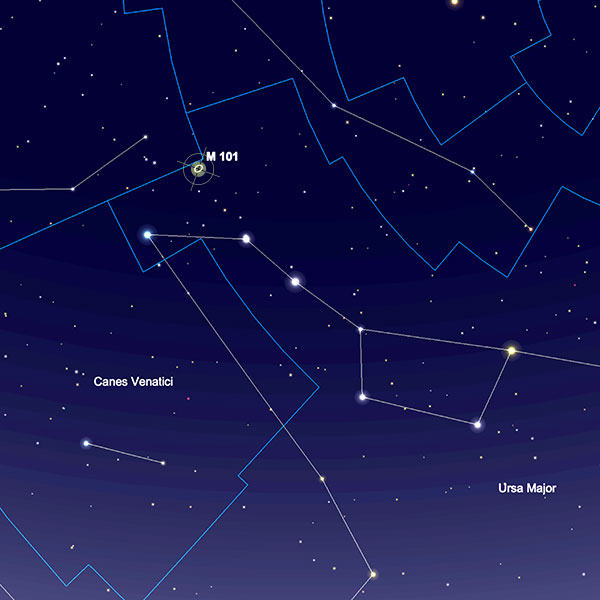
The newly discovered supernova, named SN 2023ixf, was initially identified by Koichi Itagaki on May 19th. Itagaki spotted the supernova when it was 14.9 magnitude, but it rapidly increased in brightness over last weekend. Astronomers then examined data from the Zwicky Transient Facility and uncovered the earliest evidence of the supernova two days prior to Itagaki's discovery.
With its current visibility, thought to be around magnitude 11 and thus visible in telescopes of 4-inch aperture and above (from a reasonably dark observing site), SN 2023ixf is anticipated to remain observable through amateur telescopes for several months, making it a distinctive target for observation throughout the summer.
Naturally, this is a great potential target for imaging as Keith Jones' picture below shows:
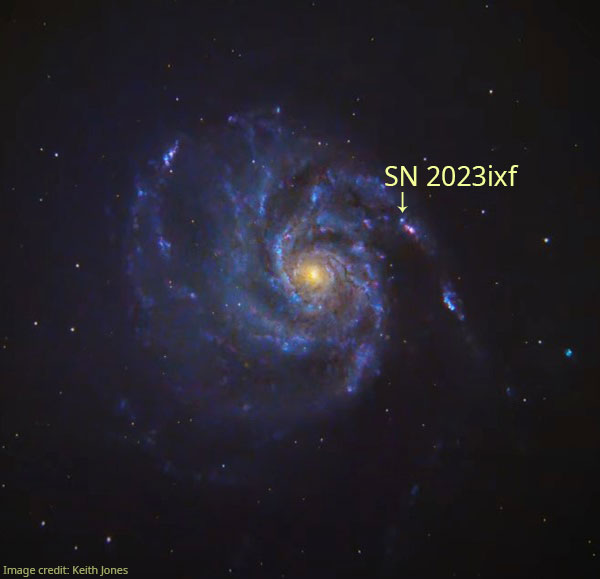
The Solar System
The Sun
The Sun continues to increase in activity and has shown some particularly spectacular displays of Sunspots and Prominences of late. Unlike many other members of the Solar System, you can actually see the Sun's surface features and atmospherics develop over the space of a day. The Sun's dynamism is quite unlike anything else in the sky to observe.
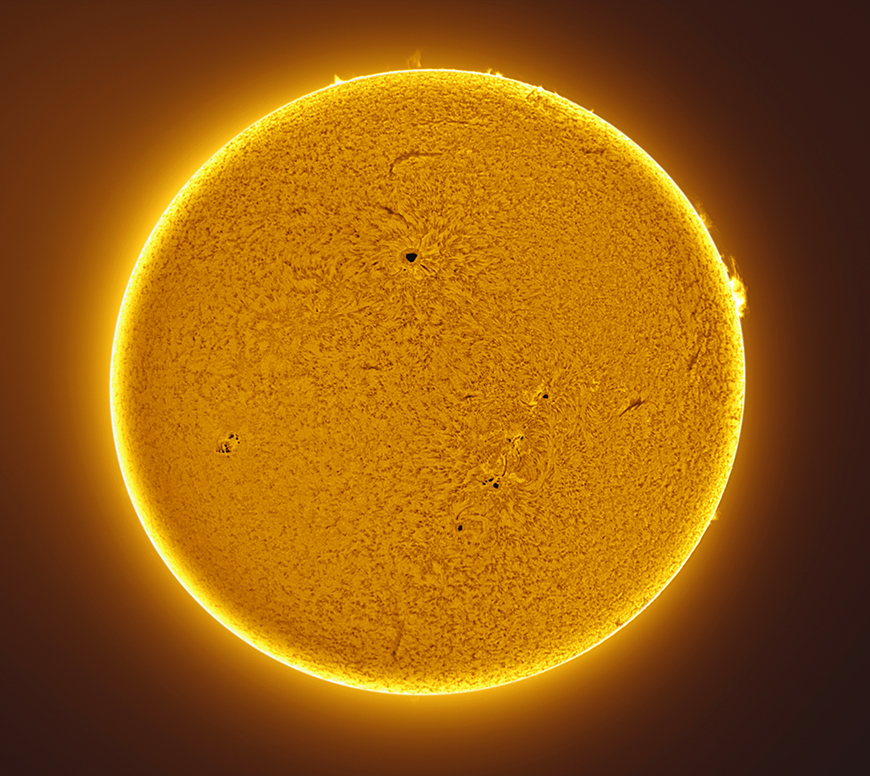
The Sun taken in late May by Telescope House's Kerin Smith, using a Lunt 60mm H-Alpha telescope.
The Moon
Our natural satellite wends its way around the Ecliptic as usual. Starting on the 1st, the month begins with the Moon in Waxing Gibbous Phase, appearing as a 93% illuminated target, low in the southern sky after sunset, in the constellation of Libra. Fast forward a few days to June 4th and the Moon will have transitioned to Full. It will have drifted into the neighbouring constellation of Scorpius by this point. Rising at around 10.30pm from European locations, it will transit at around 1am and set at 4.45am. We labour the obvious at this point: this part of the month will not be the best for deep sky viewing or astrophotography - with the Moon compounding permanent astronomical twilight for many observers.
Past this point, the Moon will slowly start to contract in phase. Passing through the extremes of the southern part of the Ecliptic through Sagittarius, Capricornus and on into Aquarius, when it will join Saturn on the early morning of the 10th, where it will also reach Last Quarter phase.
The Moon trails through Pisces and Cetus over the next few days, its crescent gradually getting thinner and thinner. On the morning on the 14th, the Moon can be found very close to the planet Jupiter, both now in Aries - the two worlds separated by just under half a degree, at closest approach.
The Moon will continue to wane as it moves through the constellation of Taurus, where it will meet the Sun and become New on the 18th. After this point, the Moon will re-emerge as an evening object, slowly becoming visible as its crescent phase increases.
On the evening of June 21st, the Moon will come into fairly loose conjunction with the very prominent Venus - and the distinctly less noticeable Mars - on the Cancer-Leo borders. The three will be found almost due west as the Sun goes down.
The Moon then begins its long trek through the large constellations of Leo and Virgo, expanding its phase as it does so. It comes to First Quarter phase in western Virgo on the evening of the 26th, spending another couple of days within the sky’s largest constellation, before exiting into Libra on the 29th. It’s in Libra, with the Moon a couple of days off Full again, that we end June from a lunar point of view.
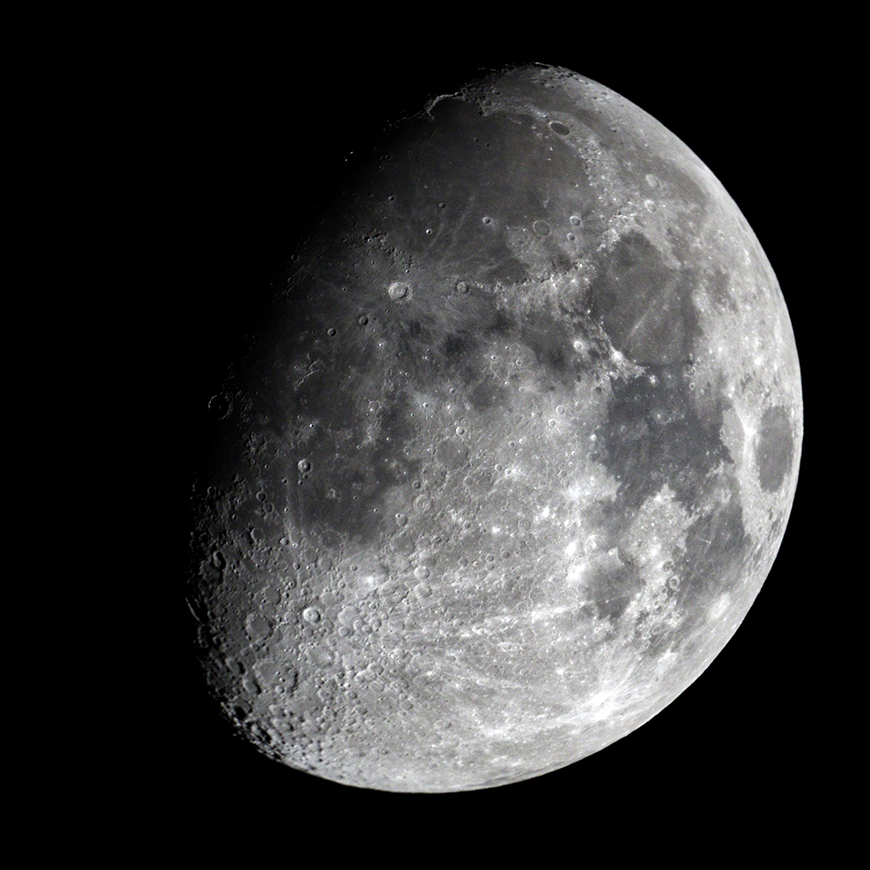
The Waxing Gibbous Moon imaged by Malcolm Porter, using an Explore Scientific David H Levy Comet Hunter 152mm f/4.8 Maksutov-Newtonian and a Canon Ra (ISO 800, 1/2000th second). Image used with kind permission.
Mercury
Mercury begins June in a very unfavourable position as far as temperate northern hemisphere observers are concerned. While the planet is just past maximum western elongation and very well-placed for observation from the equatorial regions of the Earth, it is situated in a very shallow-rising part of the Ecliptic and reaches just 5 degrees elevation at sunrise from 51 degrees N. The planet is +0.4 magnitude on the evening of the 1st.
As the month progresses, Mercury brightens a little - by the morning of the 15th it is -0.6 magnitude and now stands around 6 1/2 degrees high as the Sun rises (from 51 degrees N).
The latter half of the month sees Mercury sinking further sunward, though the planet brightens significantly as it does so. By the time we reach the morning of the 23rd, Mercury displays a -1.4 magnitude, 92% illuminated disk, which is 6.4 arc seconds in diameter. While the planet is just under 10 degrees from the Sun and stands just 4 1/2 degrees above the horizon as the Sun rises, ironically, it will be easier to locate than it was at the month’s beginning.
Mercury is looping around behind the Sun, as seen from our perspective on Earth and will reach Superior Conjunction (the opposite side of the Sun) on 1st July. The last week of June sees the planet hit close to maximum brightness (it reaches -1.9 and -2.1 magnitudes respectively, on the mornings of the 28th and 29th). Unfortunately, by this time it will be very close to the Sun and subsequently unobservable.
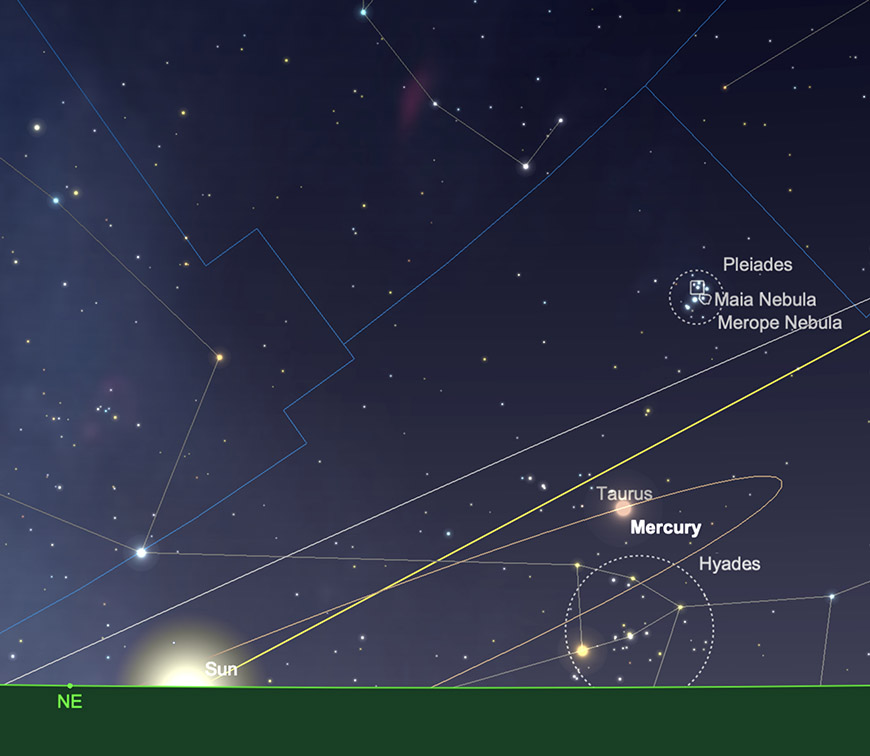
Mercury, sunrise, 15th June. Image created with SkySafari 5 for Mac OS X, ©2010-2016 Simulation Curriculum Corp., skysafariastronomy.com.
Venus
Our nearest neighbour (planetary-speaking) continues to put on a fine display in the evening sky. The 1st finds Venus at -4.3 magnitude, displaying a 51.3% illuminated disk of 22.8 arc seconds diameter. As the Sun sets (from 51 degrees N), the planet will stand just over 29 degrees high, almost due west.
Venus reaches maximum eastern elongation on the 4th June and presents a half phase similar to a First Quarter Moon (albeit a lot smaller). At this point, it is a maximum 45 degrees separation from the Sun.
As the planet continues to swing around the Sun on its faster interior orbit, it gets ever-closer, increasing its angular size and brightness, while decreasing its phase as it does so. By mid-June, Venus will be -4.4 mag and 27 arc seconds diameter, but will have decreased its phase to 42.9% illuminated.
Moving forward to the end of the month, the situation has developed further. On the 30th, Venus is a dazzling -4.5 magnitude and now presents a 33.2% illuminated, 33.4 arc second diameter disk. The only downside of this increase in brightness and angular size is that it comes at the expense of height above the horizon and inevitably separation from the Sun. On the evening of the 30th, Venus stands just over 18 degrees high in the west as the Sun sets.
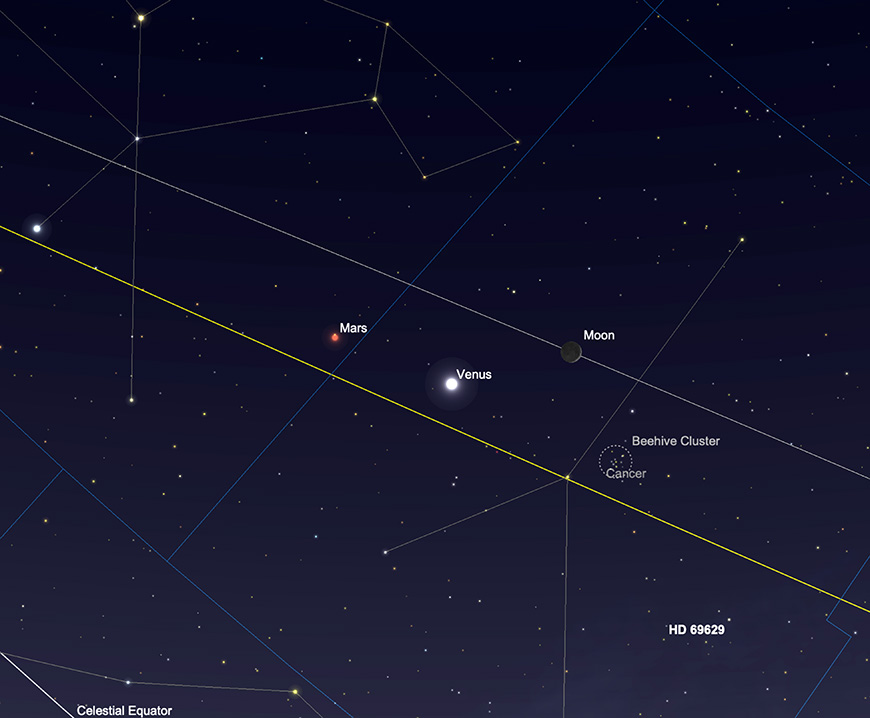
Venus, Moon and Mars, sunset, 21st June. Image created with SkySafari 5 for Mac OS X, ©2010-2016 Simulation Curriculum Corp., skysafariastronomy.com.
Mars
The Red Planet is to be found in Cancer as the month begins - though at a rather disappointing +1.6 magnitude, would be fairly easy to overlook, were the rather demure Cancer blessed with brighter principal stars.
Mars is not too far from Venus, located in neighbouring Gemini, but the contrast between the two worlds could not be starker. At just 4.7 arc seconds diameter, on the evening of the 1st, Mars is a very meagre target. And the situation only gets less inspiring as the month progresses - by the end of June, Mars has dimmed to +1.7 mag and now presents a 4.2 arc second diameter disk. It ends the month having crossed the border into Leo.
Jupiter
Jupiter is a morning target in Aries and has now emerged from the glare of post-superior conjunction to be a worthwhile, if rather low target for those of us observing in the temperate northern hemisphere. At -2.1 magnitude, Jupiter stands around 12 1/2 degrees high in the east at sunrise, separated from our parent star by around 36 degrees on the morning of the 1st.
As previously mentioned, Jupiter comes into close conjunction with the very old Crescent Moon on the 14th, which will present a lovely sight for the early riser. By mid-month, Jupiter won’t have changed dramatically at all from the beginning of June in terms of brightness or angular size.
By the time we get to the end of the month, Jupiter will have increased brightness fractionally to -2.2 magnitude and now shows a 36.5 arc second diameter disk. However, it is now significantly higher in the sky at sunrise - over 28 degrees elevation, as seen from 51 degrees N.
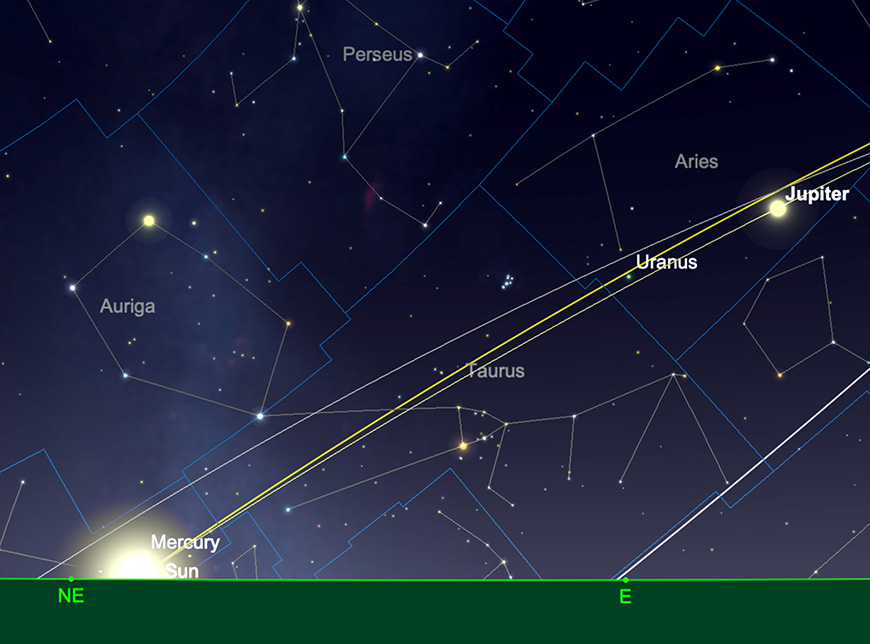
Jupiter, Sunrise, 30th June. Image created with SkySafari 5 for Mac OS X, ©2010-2016 Simulation Curriculum Corp., skysafariastronomy.com.
Saturn
Saturn is further west of Jupiter, in the constellation of Aquarius. At +1.0 magnitude on the 1st it is (as always) significantly fainter, but easy enough to locate in this rather barren part of the sky.
Saturn is just over 17 arc seconds diameter and stands around 22 1/2 degrees high in the SE (from 51 degrees N) as the Sun rises.
By the time we reach the end of June, Saturn will have increased its brightness to +0.8 magnitude and now displays an 18 arc second diameter disk. It will now stand around 28 1/2 degrees high in the south at sunrise (from 51 degrees N), just a little off transit point.
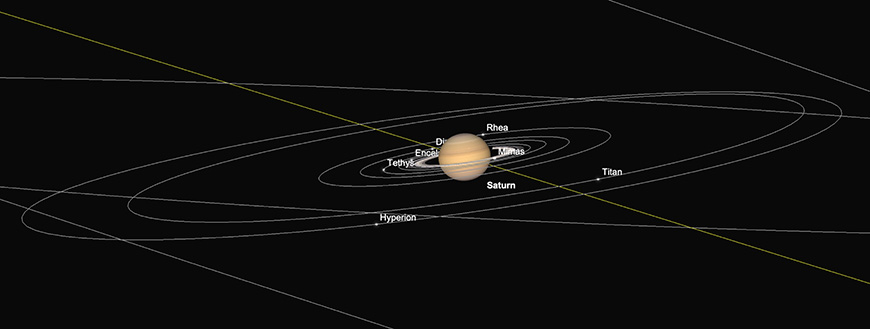
Saturn and Inner Moons, just before sunrise, 30th June. Image created with SkySafari 5 for Mac OS X, ©2010-2016 Simulation Curriculum Corp., skysafariastronomy.com.
Uranus and Neptune
Uranus is a resident of Aries and re-emerging from May’s recent Superior Conjunction and is not well-placed for early morning observations. Neptune, a little further west in the Ecliptic, in Pisces, is better separated from the Sun, at around 86 degrees separation, but still will be a victim of a combination of height above the horizon and the lighter skies at night during this time of year. There are better conditions for observing the two outer giants of our solar system, but we’ll have to wait until later in the year for them.
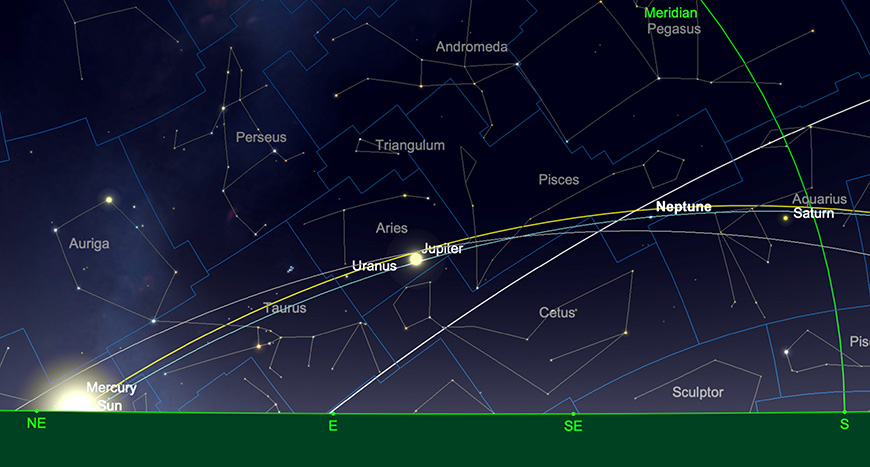
Relative positions of Uranus and Neptune, sunrise, 30th June. Image created with SkySafari 5 for Mac OS X, ©2010-2016 Simulation Curriculum Corp., skysafariastronomy.com.

 English
English

